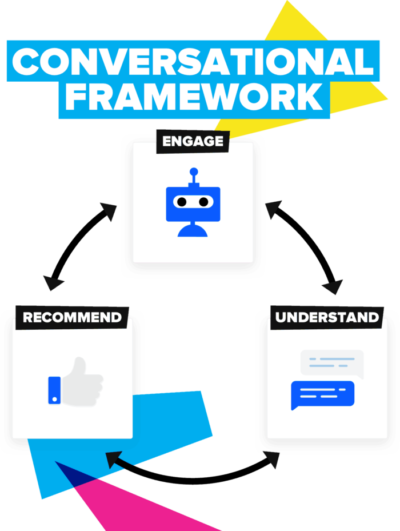
Sales development can be boiled down to three questions:
- How do we start more conversations with the right buyers?
- How do we have those conversations sooner?
- How do we use those conversations to turn buyers into customers?
In the past, a buyer might fill out a lead gen form and wait hours, sometimes days, for a response. Then? More waiting. Conversational marketing makes it possible to break the barrier and start the conversation sooner so buyers become customers faster.
Earlier this year, TOPO published its 2019 Sales Development Benchmark Report. 67% of respondents are director level or above. 29% have annual contract values (ACVs) greater than $75K. 66% have an average sales cycle (ASC) of 2-12 months.

The study demonstrates that sales development is becoming a critical function for B2B sales and marketing teams. The goal? To book high-value meetings, appointments, and calls for the sales team.
Notice those large ACVs and long ASCs, though. Typically, there are multiple decision-makers involved in those types of deals. The process is longer and every visitor is just one part of the buying team. There’s more consideration, which means heavier research (often meaning multiple visits) and competitive comparison are a given.
You’re starting to see the problem: multiple buyers visiting your site multiple times with varying levels of intent. How can a lead gen form facilitate (and maintain) all of the conversations you need over a 2-12 month period with directors, VPs and C-suite executives considering a $75K contract with you?
Put simply, it can’t.
You need to be in a position to start (and continue) conversations instantly and personalize the conversation for each member of the buying team.
That’s where conversational marketing comes into play. These types of high-intent, considered purchases are perfect for live chat and chatbots.
Let’s dive into some of the top insights at this unique intersection of sales development and conversational marketing.
Key Takeaways from the Report
1. Sales development reps (SDRs) generate $415K in pipeline per month, on average, accounting for 57% of overall pipeline.
When SDRs partner with the marketing team to add live chat and chatbots to high-intent pages, the pipeline benefits. Now SDRs are not just pulling from email, phone and LinkedIn, which are all outbound channels (i.e. the SDR is seeking out the buyer’s attention). On live chat, the buyer offers their attention willingly. The thoughtful combination of all these channels will allow SDRs to build bigger, stronger pipelines.
2. Of account-based marketers (ABMs), 88% say outbound SDRs are an important channel. 41% of organizations have built a dedicated account-based SDR team.
3. 19% of respondents have SDRs dedicated to customer expansion and 12% have SDRs dedicated to support channel partners.
4. High-growth organizations with more than 20 SDRs have dedicated enablement and operations.
The organizations investing in their SDRs are the organizations that are prospering. What’s the best way to enable your SDRs? By unlocking an entire pool of buyers who are actively looking to connect with them.
5. Average tenure of a SDR increased from 14.3 months to 15.5 months, largely thanks to skill development and internal recognition.
6. Organizations are creating processes that allow for live SDR conversations during the qualification process. 40% of respondents said live call is the key factor in their success.
Historically, the most scalable channel for SDRs has been email, but SDRs now have to compete heavily for attention thanks to the steady increase in digital communication. Instead, they’re turning to live calls to qualify leads.
What about the hundreds, if not thousands, of qualified buyers who visit your site every day? What if SDRs could start conversations with them while their intent is high, understand their needs and recommend the next best action for that particular buyer at that particular moment? That could be a meeting or a call, of course, but it could also be a guide or a webinar.
That’s the conversational marketing framework: engage, understand, recommend.

It works for SDRs on live chat, on the phone, on LinkedIn, over email – you name it. But live chat is the only channel where you can instantly understand, qualify and direct leads who are actively seeking your attention.
7. GDPR and overflowing inboxes are pushing SDRs to LinkedIn. 42% of respondents said their touch patterns include 2-5 LinkedIn touches. In Europe, some SDRs reported LinkedIn as their only outbound channel.
What do all sales development channels have in common? They all create top of funnel brand awareness, which means increased traffic to your site.
Think about it. Let’s say you send a batch of messages on LinkedIn and, on average, 60% of those buyers open your message, but only 5% actually write you back. How many buyers were a little curious and Googled your brand name to check out the website, though? That’s a missed sales opportunity.
These channels don’t work in silos. Those 2-5 LinkedIn touches are part of a holistic buying experience that spans email, phone, etc. But all roads point back to your site, right? All of that time, money and energy invested as a sales development team leads straight to your site, which is why you need to be ready to engage on-site.
There are endless ways to structure this. If a visitor is on a target account list from your CRM, you might have a SDR engage live. If not, you might use a chatbot to take the buyer through the conversational marketing framework.
It all starts with a message to pull the buyer into a conversation, like ConnectionModel:

(Psst… You can see other great examples on ReallyGoodChatBots.com.)
Once you’ve engaged, 3-4 automated questions allow a chatbot to recommend the next best step, whether that’s talking to a SDR via live chat or reviewing a piece of sales development content.
The point is that it’s all one holistic experience. The channels are working together toward a common goal.
8. Only 25% of respondents listed chat as a channel, but the report predicts that number will increase by at least 50% in 2019.
Market Overview
According to the report, the biggest challenges to sales development success are: live call execution (36%), execution of an account-based go-to-market strategy (35%), and using technology tools to increase rep activity (33%).

All three of these challenges can be tackled with conversational marketing.
Live call execution will always be a challenge and a point of optimization. Why? Because unfortunately, the feedback loop between sales and marketing is incredibly long with live calls. Waiting for transcripts from live calls and email is tedious and slows down insights.
Live chat, on the other hand, quickly shows you how well chatbot approaches are working, how well the messaging is resonating with buyers, which pages result in the most valuable conversations, etc. The alignment between sales development and marketing strengthens, which means everyone wins.
With account-based marketing, you’re deliberately going after specific companies with email, LinkedIn, phone calls, etc. Conversational ABM, which is live chat, directly addresses that second biggest struggle. When buyers from your target accounts are on your site, do you know? Are SDRs available to engage with them live?
Technology tools are constantly evolving, but as conversational marketing continues to take center stage in sales development, increasing SDR activity will be an obvious byproduct.
So, we know where the challenges are, but where are sales development teams already seeing success? According to the report: hiring and onboarding (49%), live call execution (40%), and using technology tools to increase rep activity (39%).

Many of these factors, such as hiring and clear expectations, seem like no-brainers. Of course hiring the right sales development reps and pointing them in the right direction will lead to success.
Detailed touch patterns are particularly interesting, though.
These are your “quality activities”, the activities you know lead to a bigger, stronger pipeline. What’s important is to ensure your touch pattern has a healthy balance of outbound and inbound touches. Your sales development team needs to be capitalizing on any inbound motions, like buyers actively visiting your site.
In a way, conversational marketing bridges the gap between outbound sales and inbound sales. Chatbots sit comfortably in the middle, given they are integral to both touch patterns. If you don’t make it easy for a buyer to get in touch with you right away, you’re not truly taking an omnichannel approach and you’re not truly focused on a holistic buying experience.
As marketers, we like to think of funnels in a very linear way. We think, “I’m going to push you to my site through all of these omnichannel campaigns, but when you get there, you’re going to go down one specific path that I dictate to you.” Instead, we should be thinking about how to get each unique buyer to the next stage of their unique buying experience.
Conversational marketing enables SDRs to pull buyers through the buying experience the buyers actually want and need based on their unique circumstances, not the “universal” buying experience that has been dictated for them (and everyone else).
Key Sales Development Metrics
One of the most telling parts of the report is the sales development metrics table, which is broken out by ACV:

Now, it’s common that your inbound lead conversion rate will go down as your ACV goes up. With bigger contracts, the final buying power typically rests in the C-suite, but the executive won’t necessarily be the person coming to the site regularly.
What happens when they do visit the site, though? You want them to experience a conversational ABM approach where they’re connected to a SDR who knows them and their account history.
If you’re able to increase that inbound lead conversion rate for that high-value segment, the ROI is massive. Even a small conversion rate increase at the $75K+ ACV level would be exponential for growth.
C-suite aside, though… whether it’s 10 p.m. on Saturday or 10 a.m. on Monday, when high-intent buyers are on your site, you want to capture that interest.
Note the inbound qualification definitions, especially. BANT stands for budget, authority, need, and timing. Authority is something you can determine automatically through email data enrichment with a tool like Clearbit. The other three qualification factors can be addressed with simple questions via a chatbot.
A 6-10 minute call, maybe even a 10-15 minute call… just to qualify the buyer? An on-site chatbot can qualify a buyer and have them booked for a meeting in under a minute.
Combining Sales Development and Conversational Marketing
Conversational marketing doesn’t alter sales development, it enhances it. It smoothes out the edges and makes sales development reps more efficient. Conversational marketing is just one part of an overall inbound and outbound sales strategy, but it’s the glue that holds the cohesive buying experience together.
As the report confirms, SDRs who leverage technology tools efficiently will be the ones who get ahead. Conversational marketing tools, like live chat and chatbots, allow SDRs to focus on the highest intent, most valuable leads and accounts.






